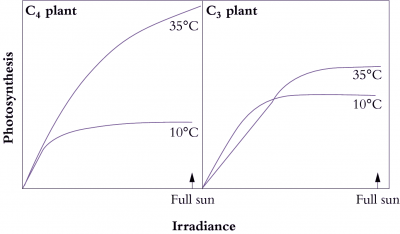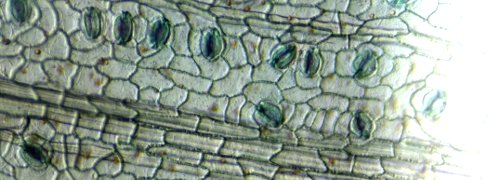Figp2.06.png

Figure 2.7. Generalised light response curves for leaf photosynthesis show that C4 plants assimilate comparatively faster at high temperature (35°C), but that C3 plants are advantaged at low temperature (10°C). Photorespiration increases with temperature, and is largely responsible for this contrast. C4 plants are equipped with a CO2-concentrating device in their bundle sheath tissue which both enhances Rubisco’s performance at that location, and forestalls photorespiratory loss. (Original drawings coustesy M.D. Hatch).
One disadvantage of the C4 pathway is that an energy cost is incurred by C4 plants to run the CO2 ‘pump’. This is due to the ATP required for recycling PEP from pyruvate by the chloroplastic enzyme pyruvate, Pi dikinase in the mesophyll cells (Figure 2.4 and Hatch 1987). Under ideal conditions, five ATP and two NADPH are required for every CO2 fixed in C4 photosynthesis (two ATP are required to run the CO2 pump, i.e., regenerate PEP). In addition, a proportion (20-30%) of CO2 fixed by PEP carboxylase in the mesophyll is not fixed by Rubisco in the bundle sheath, and subsequently leaks back to the mesophyll. This leaked (or overcycled) CO2 represents an additional, inherent energetic cost of the C4 pathway.
From the previous section, the C4 pathway is obviously energetically more expensive than the C3 pathway in the absence of photorespiration. However, at higher temperatures the ratio of RuBP oxygenation to carboxylation is increased and the energy requirements of C3 photosynthesis can rise to more than five ATP and three NADPH per CO2 fixed in air (for these calculations see Hatch 1987).
Representative light response curves for photosynthesis in C3 cf. C4 plants (Figure 2.7) can be used to demonstrate some of these inherent differences in photosynthetic attributes. At low temperature (10°C in Figure 2.7) a C3 leaf shows a steeper initial slope as well as a higher value for light-saturated photosynthesis. By implication, quantum yield is higher and photosynthetic capacity is greater under cool conditions. In terms of carbon gain and hence competitive ability, C3 plants will thus have an advantage over C4 plants at low temperature and especially under low light.
By contrast, under warm conditions (35°C, upper curves in Figure 2.7) C4 photosynthesis in full sun greatly exceeds that of C3, while quantum yield (inferred from initial slopes) remains unaffected by temperature. Significantly, C3 plants show a reduction in quantum yield under warm conditions (compare 10°C and 35°C curves; right side of Figure 2.7). At 35°C C3 plants also show lower rates of light-saturated assimilation compared with C4 plants. Increased photorespiratory losses from C3 leaves at high temperature are responsible (Section 2.3). C4 plants will thus have a competitive advantage over C3 plants under warm conditions at both high and low irradiance.
